As we drove into the Carrizo Plain from the south end, past the oil rigs and pump jacks in Maricopa, I could see that this was not going to be the verdant spring visit I had anticipated. The land looked beat up and tired. Soda Lake was dry. The lumpy hills of the Temblor Range were devoid of vegetation. And the washboarded road was playing havoc with our little camper/van. Nevertheless we pushed on. And I became entranced once again with the sheer size and austere distances we were traversing. And here and there I could see bursts of color. A splash of goldfields in the chaparral. A small bunch of roadside poppies. A lupine or two. These were the plants that were somehow hearty enough to reach full bloom.
But our ultimate goal was to get a campsite in the KCL Campground, get settled in, and come up with a new strategy for exploring the Carrizo. The campground in question has only about ten sites, and even fewer trees. Questionable water (high in nitrates). And a resident pair of Great Horned Owls who dwell in the large eucalyptus there. As fate would have it, all the sites were taken. Including a group site full of boy scouts from Santa Margarita.
In all the times I have camped here I have never seen a ranger of any type (it is managed by the Bureau of Land Management) nor are there any fees charged so, as unobtrusively as possible, we parked our van over to one corner of the camp and no one seemed to notice or to care. In fact, the resident campers were downright friendly. Across the way, Ren was traveling with her 16-year old cat, pretty much living out of her car. She looked to be in her late 40s perhaps, in sloppy t-shirt and cargo pants. Probably a real looker at one time but now missing four of her front teeth, and quick to tell us about her family’s ups and downs.
Next to us were two women who looked like researchers. They had vials and killing jars and other various paraphernalia, and after talking to one of them, Sara, turned out they were, indeed, researchers trying to re-introduce important pollinators back into the valley. Meanwhile, on the far side of the camp, live music was emanating from a campsite with two young men and two young women. Fiddle, banjo, mandolin, guitar. Bluegrass music and songs that laid down a quiet soundtrack to the afternoon.
Ren was having trouble putting up her tent so one of the bluegrass boys came over to help. Sara went to loan her a mallet. Meanwhile, a pair of campers who came in late, asked us if they could set up behind our van and, of course, we said yes. Later on I loaned them a table so they wouldn’t have to cook on the ground. A Scout leader who had locked his keys in his car was appreciative when we gave him a wire coat hanger. Throughout the camp there seemed to be a real feeling of camaraderie and appreciation for where and who we were.
As the sun disappeared over the dark hills to the west, the hooting of the owls provided an impromptu chorus for the bluegrass players. Campfires popped up all around us, and I had visions of the migrant camps in The Grapes of Wrath. And when darkness took over, Orion rose into the center of the sky as if to watch over us and protect us all. The Carrizo Plain no longer seemed austere and foreboding. Our little campground was a beacon of goodwill and good feelings against the cold April night. A small group of human beings huddled under a living canopy, pinpoints of light and life in a vast and seemingly endless landscape. Under Orion’s belt, we were caught up in the mystique and the magic of this raw and beautiful plain




